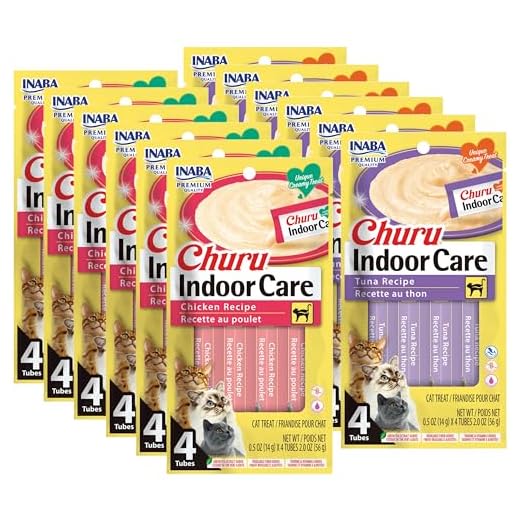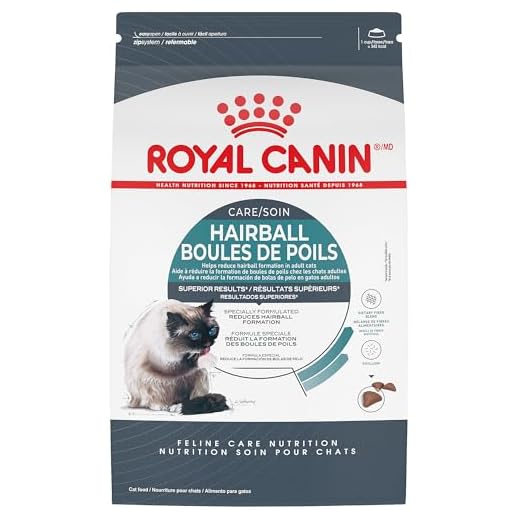



To alleviate the discomfort caused by fur clumps in your feline friend, incorporating a high-fiber diet is key. Foods specifically designed to support digestive health can minimize the formation of these troublesome masses. Additionally, regular grooming sessions can significantly reduce the amount of loose fur that your cat ingests.
This article provides practical insights and methods to address the challenges posed by furball formation in cats. It will benefit cat owners seeking to improve their pets’ well-being and enhance their quality of life. You’ll discover dietary recommendations, grooming techniques, and useful products that can help manage this common issue.
In summary, addressing this condition involves a combination of dietary adjustments, grooming practices, and the use of specialized products. By implementing these strategies, you’ll contribute to your cat’s comfort and overall health, reducing the frequency and severity of fur-related problems.
Effective Solutions for Managing Feline Fur Buildup
Regular grooming is a key strategy to minimize the occurrence of fur clumps in felines. Daily brushing helps remove loose hair, preventing it from being ingested during self-grooming. This simple routine not only reduces the likelihood of obstructions but also enhances the bond between pet and owner.
Incorporating specialized dietary options can greatly assist in managing this condition. Look for formulations that contain increased fiber content, which aids in digestive health and helps hair pass through the gastrointestinal tract more smoothly. Additionally, certain supplements containing natural ingredients like pumpkin or flaxseed oil can promote healthy digestion and reduce fur accumulation.
Additional Approaches for Prevention
Consider these methods to further support your feline’s digestive well-being:
- Hydration: Ensure your cat has easy access to fresh water, as proper hydration supports overall digestive function.
- Regular Vet Check-ups: Schedule routine veterinary visits to monitor health and address any underlying issues related to fur management.
- Playtime and Exercise: Encourage physical activity to keep your cat active and stimulate digestion.
Identifying and addressing symptoms early can prevent complications. Watch for signs such as vomiting or changes in appetite, which may indicate that intervention is needed. A proactive approach is essential for maintaining your feline’s comfort and health.
Understanding the Causes of Hairball Formation
Regular grooming is crucial for minimizing the accumulation of fur in the digestive tract of felines. Hairballs typically occur due to excessive grooming, which leads to the ingestion of loose hair. Cats often groom themselves to maintain cleanliness, but this behavior can result in the ingestion of more hair than they can naturally expel.
Another factor contributing to the formation of these fur masses is the cat’s diet. Low-quality food lacking in sufficient fiber can hinder proper digestion and lead to hairball issues. A balanced diet rich in fiber helps facilitate the movement of hair through the digestive system, reducing the likelihood of blockages.
Factors Influencing Fur Accumulation
Several specific elements play a role in the development of these unwanted masses:
- Grooming Habits: Long-haired breeds are more prone to hairballs due to their need for more frequent grooming.
- Seasonal Shedding: Cats shed more during certain seasons, increasing the amount of hair ingested during grooming.
- Stress: Stressful situations can lead to over-grooming, exacerbating the problem.
- Health Issues: Conditions like allergies or skin problems can cause cats to groom excessively.
Understanding these causes allows pet owners to take proactive measures to help minimize the risk of hairball formation. Regular grooming, a balanced diet, and monitoring stress levels can significantly contribute to a cat’s digestive health.
Effective Home Remedies for Hairball Prevention
Regular grooming significantly reduces the chances of your feline friend developing uncomfortable clumps of fur in their digestive system. Brushing your pet at least a few times a week helps remove loose hairs and minimizes ingestion during self-grooming.
Incorporating specific dietary elements can also aid in preventing these troublesome formations. Consider adding a small amount of fiber-rich food or supplements to their regular meals. This can help facilitate digestion and encourage smoother passage of hair through the intestines.
Natural Ingredients to Consider
- Pumpkin: Plain canned pumpkin is a great source of fiber. A teaspoon mixed into their food can help regulate digestion.
- Olive Oil: A small amount can help lubricate the digestive tract, making it easier for fur to pass through.
- Broccoli: Chopped broccoli can provide additional fiber and nutrients. Introduce it gradually to their diet.
Hydration also plays a key role in maintaining digestive health. Ensure your pet has access to fresh water at all times, as adequate fluid intake can help prevent constipation and facilitate smoother digestion.
- Regular grooming sessions.
- Incorporate fiber-rich foods like pumpkin and broccoli.
- Use olive oil sparingly to aid digestion.
- Encourage drinking water to stay hydrated.
By combining these strategies, you can create a supportive environment to help your furry companion avoid the discomfort associated with fur clogs. This proactive approach not only enhances their digestive health but also contributes to overall well-being.
Commercial Products to Manage Hairballs
Several commercial options exist to assist in managing the issue of fur clumps in felines. These products often contain specific ingredients that promote smoother digestion and help eliminate unwanted fur from the digestive tract.
Many formulations include dietary fibers, which can facilitate the passage of hair through the intestines. Additionally, some items come enriched with oils that provide lubrication, further aiding in the movement of fur. Selecting the right product tailored to a cat’s dietary preferences and health needs is essential.
Types of Commercial Products
- Gels and Pastes: These are usually flavored to appeal to pets and can be administered easily. They often contain ingredients such as malt or oils that aid in digestion.
- Specialized Dry Foods: Certain brands offer kibble specifically formulated to reduce fur formation. These diets typically contain higher fiber content to support gastrointestinal health.
- Treats: There are various treats designed to assist in the reduction of fur accumulation. They often contain similar ingredients to gels, providing a palatable option for pets.
When choosing a product, consult with a veterinarian to ensure it aligns with the specific health requirements of the feline. Monitoring the cat’s response to the chosen product can help in determining its effectiveness over time.
Regular grooming also complements the use of these commercial solutions by reducing the amount of loose fur available for ingestion. Combining products with a consistent grooming routine may yield better results in managing fur issues.
Dietary Changes to Reduce Hairball Incidence
Incorporating high-fiber foods into a feline’s diet can significantly minimize the formation of digestive clumps. Fiber aids in the passage of fur through the gastrointestinal tract, reducing the likelihood of blockages. A blend of wet and dry food can enhance hydration and digestion, which are crucial for maintaining healthy gastrointestinal function.
Consider introducing ingredients such as pumpkin, psyllium, or brown rice into meals. These components not only promote digestive health but also provide essential nutrients. Gradually transitioning to a fiber-rich diet can help avoid gastrointestinal upset and ensure a smooth adjustment.
Additional Dietary Tips
Monitor the overall calorie intake to maintain a healthy weight. Overweight felines may struggle more with hair collection and digestion. Regular grooming also plays a role in minimizing fur ingestion. Here are some strategies to consider:
- Choose high-quality, balanced cat food that lists protein sources at the top of the ingredient list.
- Avoid feeding too many treats, especially those high in fat and low in fiber.
- Incorporate wet food options to increase moisture intake, which can aid digestion.
- Consider specially formulated diets that target digestive health and hairball management.
Regular vet consultations can provide tailored dietary advice based on individual health needs. Keeping track of dietary changes and their effects on fur accumulation will allow for better management of this common issue.
When to Consult a Veterinarian for Hairball Issues
Seek veterinary advice if your feline companion experiences persistent vomiting or if hairballs are accompanied by blood. These symptoms may indicate underlying health concerns that require professional evaluation.
If your pet exhibits signs of distress, such as lethargy, loss of appetite, or constipation, a consultation is warranted. Early intervention can prevent complications and ensure your cat’s well-being.
Key Signs to Watch For:
- Frequent vomiting of hairballs
- Presence of blood in vomit or stool
- Persistent coughing or gagging
- Loss of appetite or weight loss
- Signs of pain or discomfort
- Constipation or difficulty passing stool
Regular check-ups with a veterinarian can help manage your cat’s overall health and address any potential issues related to fur ingestion. Maintaining open communication with your vet is crucial for your pet’s long-term wellness.
Best treatment for hairballs in cats
Features
| Part Number | 18166315 |
| Model | 444207 |
| Warranty | With nearly 50 years of scientific research and observation, Royal Canin continues to deliver targeted nutrition to feed every pet’s magnificence. Not satisfied? Then neither are we. Our formulas are 100% satisfaction guaranteed. (Just contact us for more details.) |
| Size | 6 Pounds (Pack of 1) |
Features
| Size | 4.25 oz (Pack of 3) |
Features
| Size | 1 Count (Pack of 1) |
Features
| Part Number | 410621-3 |
| Model | 410621-3 |
Features
| Part Number | PROVDC80 |
| Model | PROVDC80 |
| Warranty | 2 year warranty |
| Color | blue |
| Size | 80 Count |
Features
| Model | VC-a1-104417 |
| Size | 0.5 Fl Oz (Pack of 48) |
Features
| Part Number | 630220 |
| Model | 630220 |
| Warranty | With nearly 50 years of scientific research and observation, Royal Canin continues to deliver targeted nutrition to feed every pet’s magnificence. Not satisfied? Then neither are we. Our formulas are 100% satisfaction guaranteed. (Just contact us for more details.) |
| Color | No artificial color |
| Size | 6 Pound (Pack of 1) |
Video:
FAQ:
What are the most common methods to treat hairballs in cats?
There are several effective methods to manage hairballs in cats. One common approach is to use specialized hairball control cat food, which contains higher fiber content to help reduce the formation of hairballs. Additionally, regular grooming can significantly decrease the amount of loose fur your cat ingests during self-grooming. Some pet owners also find success with hairball control treats or supplements that aid digestion and help hair pass through the system more easily. Lastly, ensuring your cat stays hydrated can also contribute to better digestion and hairball management.
How can I tell if my cat has a severe hairball problem?
Signs of a severe hairball issue in cats can include frequent vomiting, especially if hairballs are being expelled often. Other indicators are persistent coughing or gagging that seems to be related to hairballs. If your cat is showing signs of discomfort, such as lethargy, loss of appetite, or constipation, it may be time to consult with a veterinarian. They can provide insights on whether the hairball issue is serious and recommend appropriate treatments or dietary changes to help your cat feel better.











